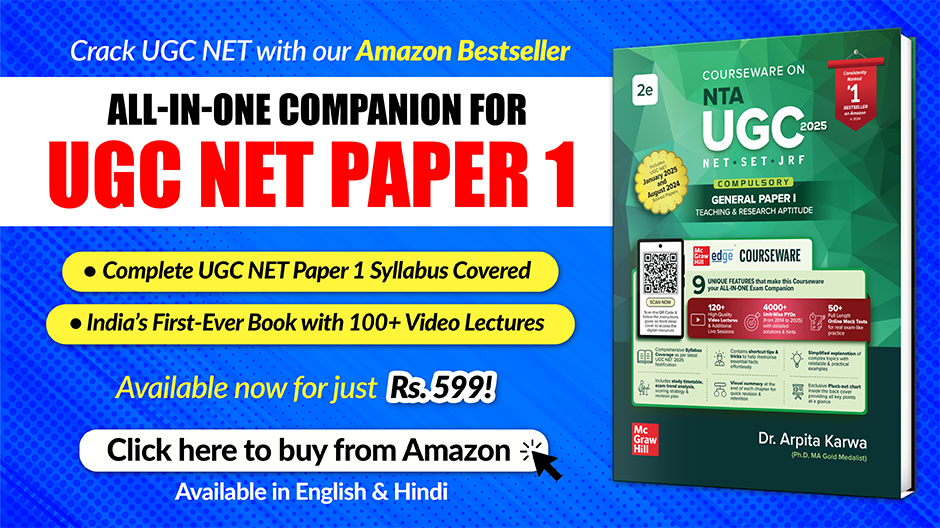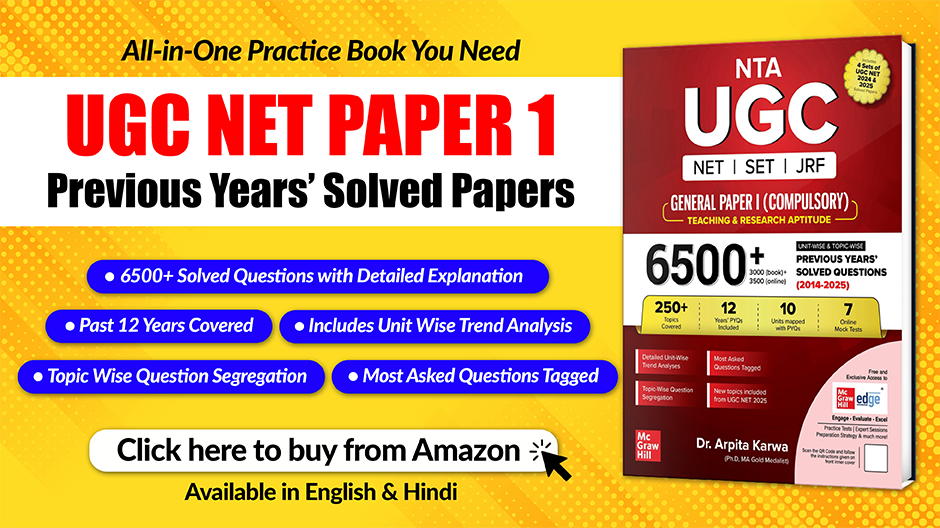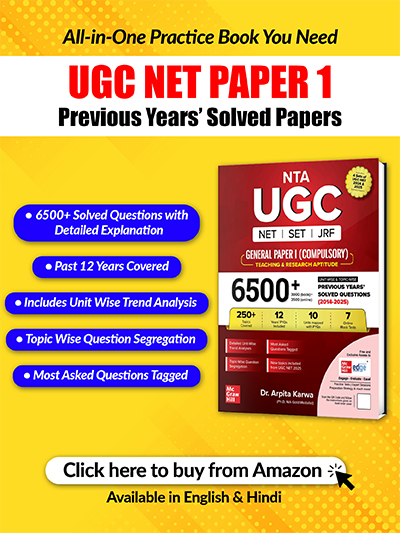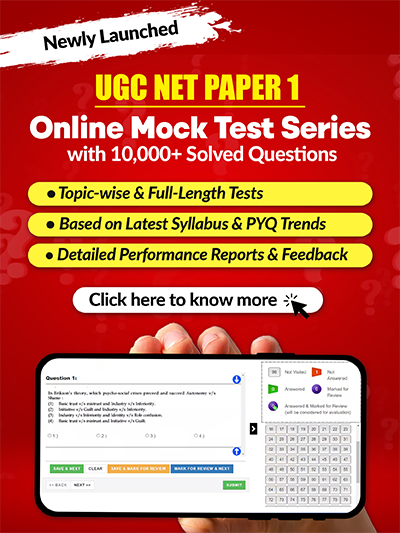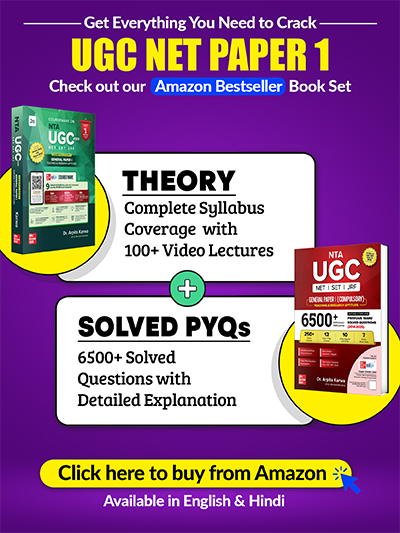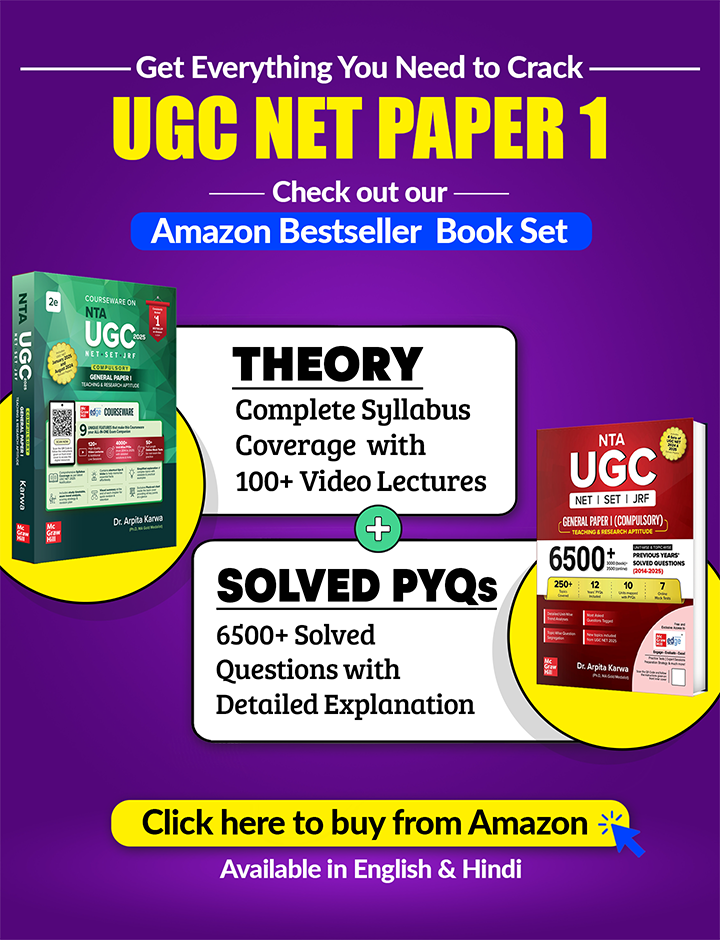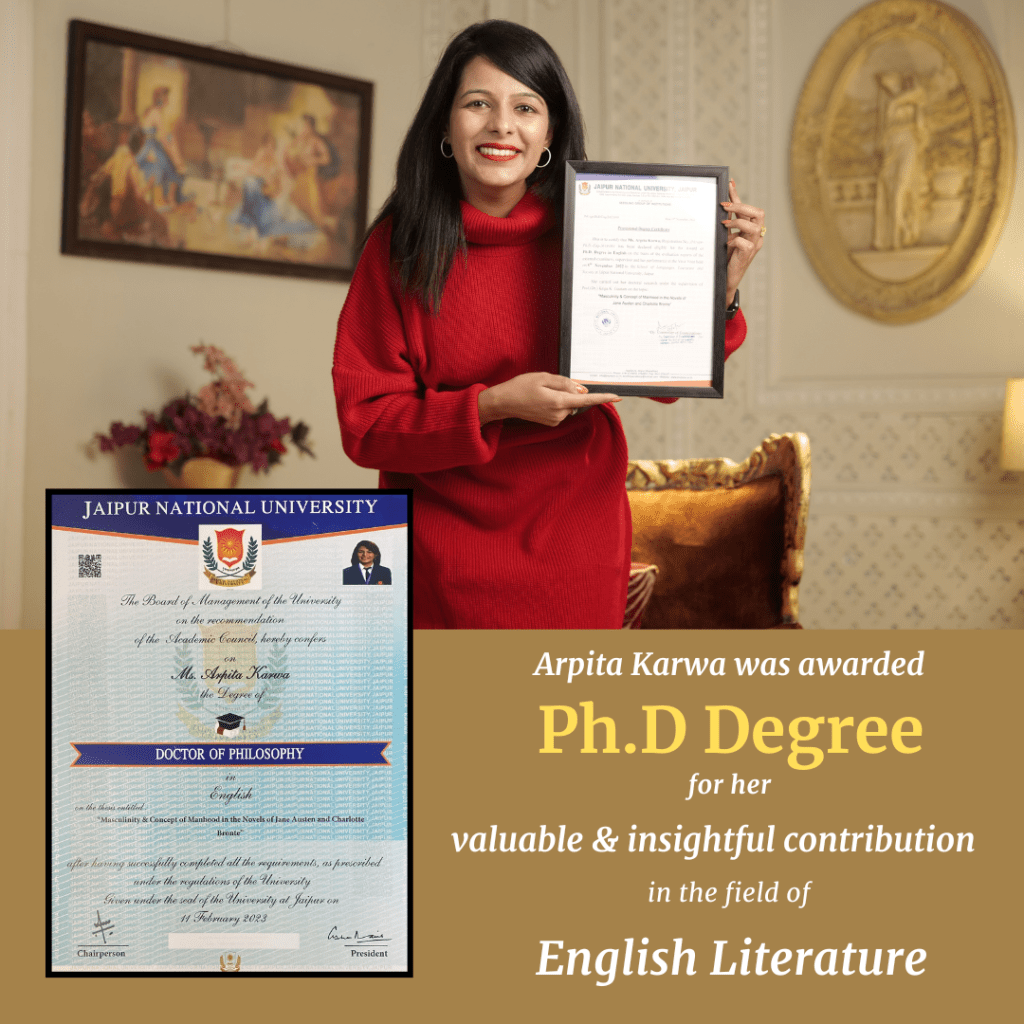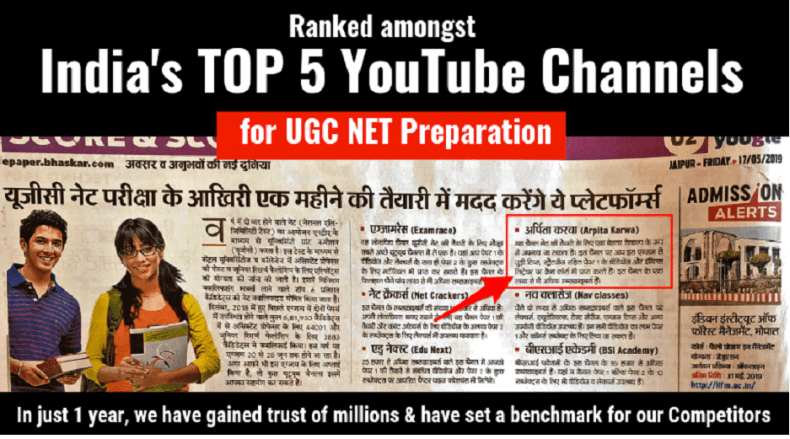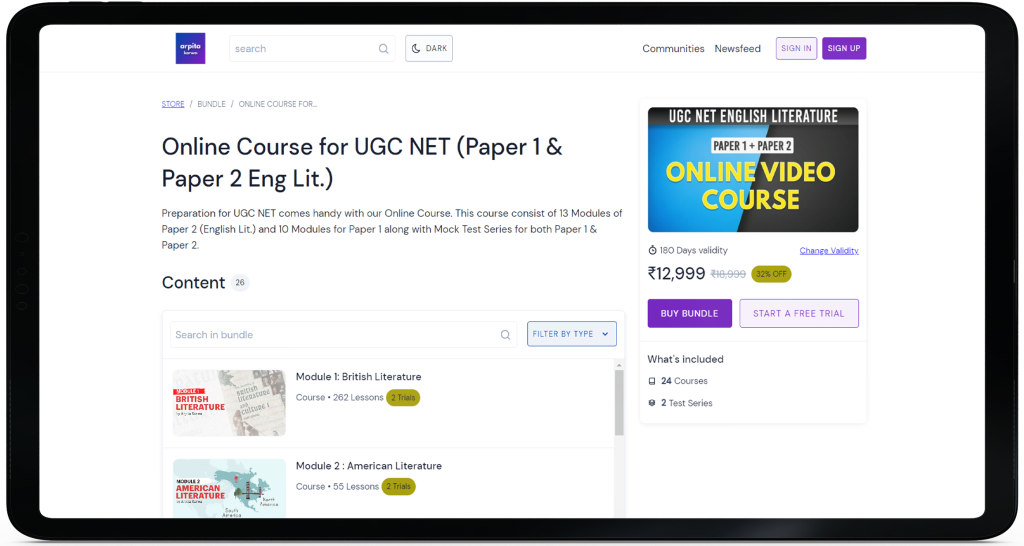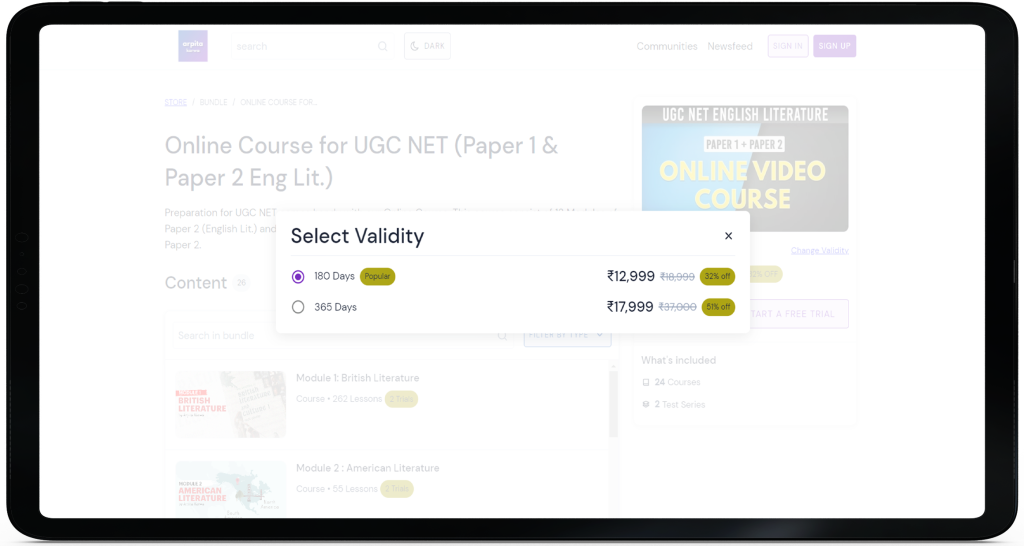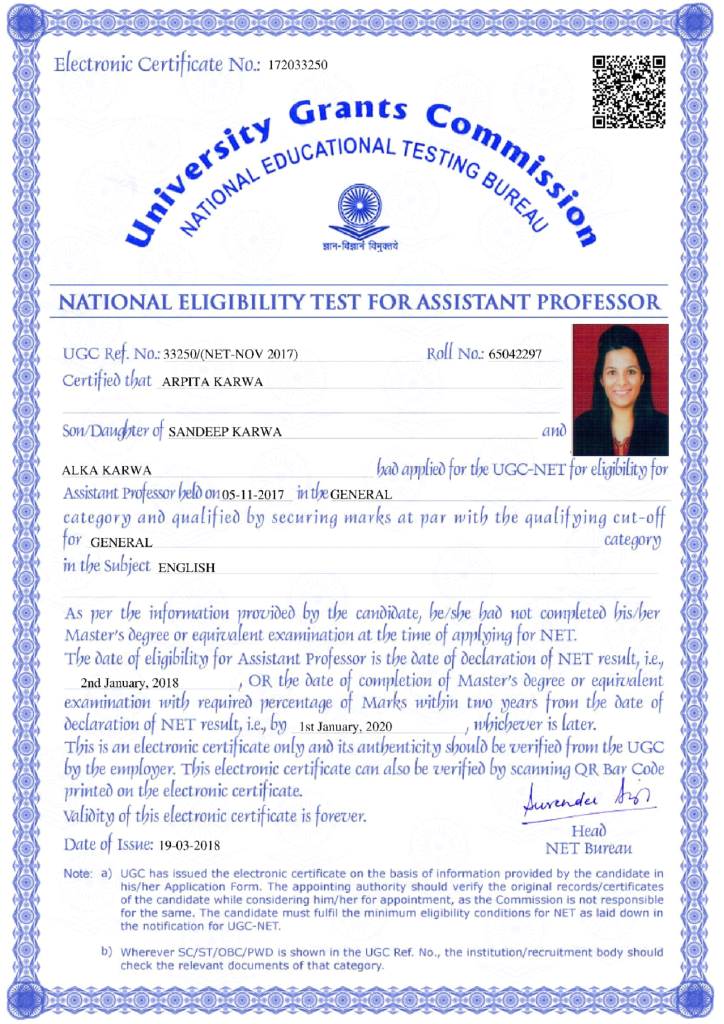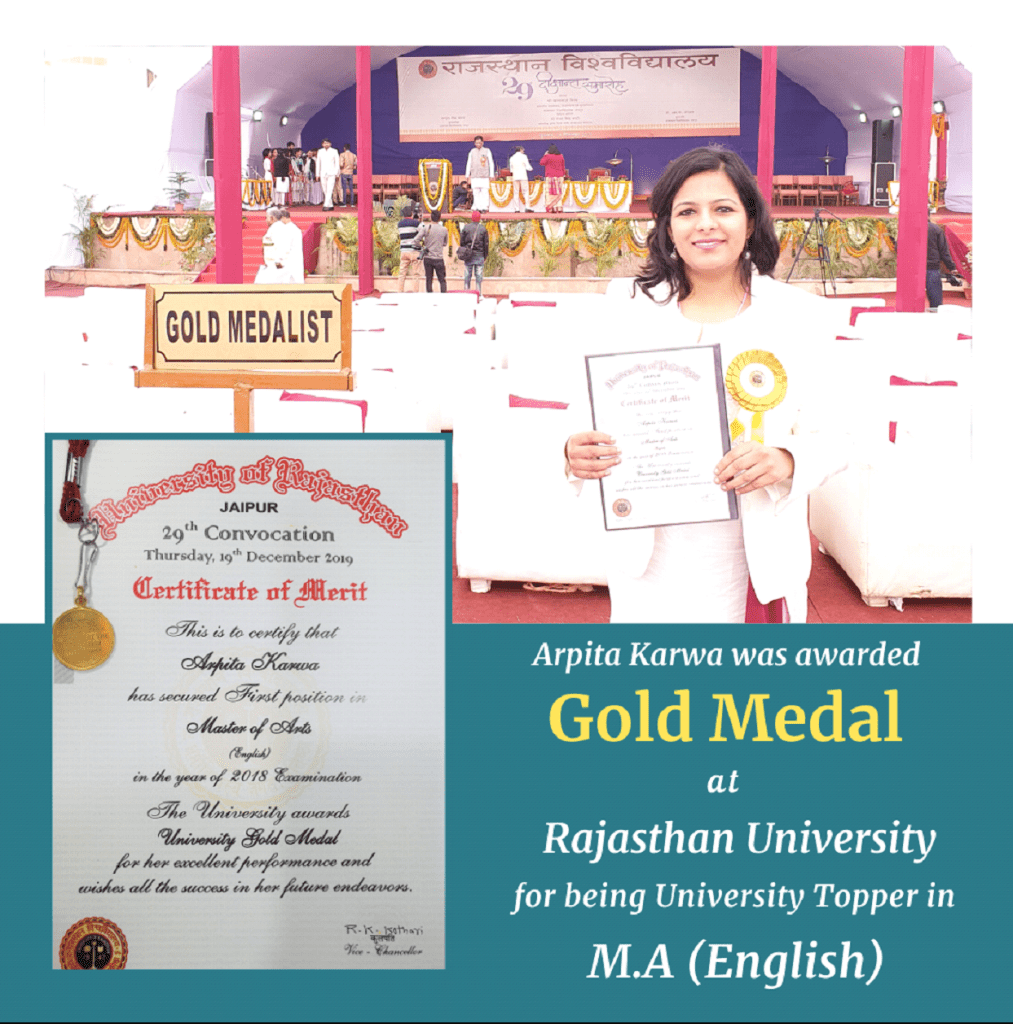UGC NET Paper 1 October 2020 (Conducted on 17th October 2020 : Evening Shift)
October 18, 2022 2025-08-18 13:58UGC NET Paper 1 October 2020 (Conducted on 17th October 2020 : Evening Shift)
October 2020: Paper 1 (Conducted on 17th Oct 2020 : Evening Shift)
Q.1-5)
Q.1) If the batsman played 14 innings against Sri Lanka in ODI and remained not out in 5 innings, then the average runs scored by the batsman against Sri Lanka are :
[1] 28
[2] 24
[3] 26
[4] 22
Correct Answer: 1
Q.2) Total runs scored by the batsman against New Zealand in T20 matches are approximately what percent (%) of the total runs scored against Pakistan in ODI matches?
[1] 64%
[2] 66%
[3] 62%
[4] 68%
Correct Answer: 4
Q.3) In the case of which of the following countries, the difference between the runs scored by the batsman in ODI and T20 is the second lowest?
[1] SriLanka
[2] Pakistan
[3] South Africa
[4] West Indies
Correct Answer: 3
Q.4) The runs scored by the batsman against West Indies in T20 are approximately what percent (%) of the runs scored against Australia in ODI?
[1] 71%
[2] 75%
[3] 73%
[4] 69%
Correct Answer: 3
Q.5) If the batsman had scored 280 runs against Pakistan in T20 matches, then what would have been the percentage of runs scored by the batsman in the T20 matches against all other countries (Assuming that the total runs scored by the batsman in T20 remains the same (that is 2000))?
[1] 88%
[2] 84%
[3] 86%
[4] 90%
Correct Answer: 3
Q.6) For optimising learning outcomes which of the following factors have been identified as most effective in terms of research evidences in the global context?
[1] Home related factors
[2] School related factors
[3] Teacher related factors
[4] Supplementary technological devices related factors
Correct Answer:
Q.7) What is the hallmark of reflective teaching?
[1] Clear, organized and well structured content
[2] Personalized, interactive and high level of cognitive interchange
[3] Systematic. planned and quick question-answer session
[4] Logical. coherent and example based presentations
Correct Answer: 2
Q.8) Identify the correct sequence of cognitive behaviours in the taxonomy of educational objectives :
(A) Knowledge
(B) Application
(C) Understanding
(D) Analysis
(E) Synthesis
[1] ABCDE
[2] DEABC
[3] ACBDE
[4] DEACB
Correct Answer: 3
Q.9) In which scale of measurement, classification, order and equality of units are ensured?
[1] Ordinal
[2] Nominal
[3] Interval
[4] Ratio
Correct Answer: 3
Q.10) Statement I: Computer based testing ensures high reliability and validity in the process of evaluation centred on effective and conative domains of behaviour.
Statement II: Support materials in the form of programmed instructional models have a tremendous potential to maximize learning.
[1] Both Statement I and Statement II are true
[2] Both Statement I and Statement II are false
[3] Statement I is correct but Statement II is false
[4] Statement I is incorrect but Statement II is true
Correct Answer: 4
Q.11) Which argument may be advanced in support of action research in education?
[1] The researcher breaks fresh ground in the field of enquiry.
[2] The knowledge is applied to extend further generalization.
[3] Some new principles are formulated for explaining the events.
[4] The educational situation as well as the practitioner of education undergo a change for the better.
Correct Answer: 4
Q.12) The critical difference between experimental and ex post facto research lies in terms of :
[1] Selection of sample
[2] Causal connection hetween two variables
[3] Use of research tools
[4] Control and manipulation of independent variable
Correct Answer: 4
Q.13) In establishing a research problem for a PhD level course, in the initial stage which of the following stages are crucial?
(A) Hypothesis making
(B) Locating a problem area from a field through survey of related literature
(C) Defining the population of research and its characteristics
(D) Selecting a pointed issue called a problem by a process of logical analysis
(E) Defining and delimiting the problem
[1] BDE
[2] BCD
[3] ABC
[4] CDE
Correct Answer: 4
Q.15) From the following, identify those which are called non-probability sampling procedures :
(A) Systematic sampling
(B) Quota sampling
(C) Stratified sampling
(D) Purposive sampling
(E) Snowball sampling
[1] ABC
[2] BCD
[3] BDE
[4] CDE
Correct Answer: 3
Q.15) Statement I: The goal of inquiry in fundamental research is directed at bringing an increment in the fund of knowledge.
Statement II: Action research is a research by the practitioner, for the practitioner and of the practitioner.
[1] Both Statement I and Statement II are true
[2] Both Statement I and Statement II are false
[3] Statement I is correct but Statement II is false
[4] Statement I is incorrect but Statement II is true
Correct Answer: 1
Q.16) Announcement of arrival and departure of trains at railway stations is :
[1] Spatial communication
[2] Organisational communication
[3] Public communication
[4] Sectional communication
Correct Answer: 3
Q.17) Factors that contribute for effective classroom communication are :
(A) Information overload
(B) Use of unfamiliar words
(C) Balanced flow of words
(D) Circular flow of messages
(E) Mechanism to assess the feedback
[1] ABC
[2] BCD
[3] ADE
[4] CDE
Correct Answer: 4
Q.18) Statement I: The content and style of communication are the predictor variables of effective teaching.
Statement II: A good and communicative teacher evokes relatively less questions from the students.
[1] Both Statement I and Statement II are true
[2] Both Statement I and Statement Il ave false
[3] Statement I is correct but Statement II is false
[4] Statement I is incorrect but Statement II is true
Correct Answer: 3
Q.19) Find out the correct sequence of the following transmissions :
(A) Narrowcasting
(B) Telegraph
(C) Broadcasting
(D) Telephone
(E) Podcasting
[1] ACBED
[2] BDCAE
[3] CDEAB
[4] DEABC
Correct Answer: 2
Q.20) Match the column:
A. A company boss telephones his/her secretary for some help from outside
B. A company issues a circular of guidelines for its employees
C. Employees discuss certain issues among themselves
D. A company sends a formal letter to its retailers and wholesalers
I. marketing communication
II. horizontal communication
III. veritcal communication
IV. informal communication
[1] A-IV B-III C-II D-I
[2] A-I B-II C-III D-IV
[3] A-II B-III C-IV D-I
[4] A-III B-IV C-I D-II
Correct Answer: 1
Q.21) Statement I: If an article is sold at a gain of 19%, then selling price is 109% of cost price.
Statement II: If an article is sold at a loss of 9%, then selling price is 109% of cost price.
[1] Both Statement I and Statement II are correct
[2] Both Statement I and Statement II are incorrect
[3] Statement I is correct but Statement II is incorrect
[4] Statement I is incorrect but Statement II is correct
Correct Answer: 2
Q.22) Find odd one out in from the following :
5, 7, 12, 17, 19, 23
[1] 7
[2] 12
[3] 17
[4] 19
Correct Answer: 2
Q.23) At what angle the hands of a clock are inclined at 15 minutes past 5?
[1] 58 1/2°
[2] 67 1/2°
[3] 68 1/2°
[4] 72 1/2°
Correct Answer: 2
Q.24) Statement I: A number is divisible by 3, if the sum of its digits is divisible by 3.
Statement II: A number is divisible by 9, if the sum of its digits is not divisible by 9.
[1] Both Statement I and Statement II are correct
[2] Both Statement I and Statement II are incorrect
[3] Statement I is correct but Statement Il is incorrect
[4] Statement I is incorrect but Statement II is correct
Correct Answer: 3
Q.25) The difference between the squares of two consecutive numbers is 35. The smaller number is
[1] 14
[2] 15
[3] 16
[4] 17
Correct Answer: 4
Q.26) Identify the characteristics of the ‘middle term’ from the following :
(A) It must be present in the minor term
(B) It must be present in all positive instances in which the major term is present
(C) It is the logical statement which is to be proved
(D) It must be absent in all negative instances in which major term is absent
(E) It is drawn from the preceding propositions
[1] ABC
[2] BCD
[3] CDE
[4] ABD
Correct Answer: 4
Q.27) ‘Upanaya’ in Indian ‘Nyaya Syllogism’ corresponds to which of the following in Aristotelian Syllogism?
[1] Major premise
[2] Minor premise
[3] Conclusion
[4] Both major and minor premises
Correct Answer: 2
Q.28) “Fire is not warm because it is produced such as water”, is an example of which type of fallacy?
[1] Satpratipraksha
[2] Badhit-vishaya
[3] Virudha
[4] Swaroopasidha
Correct Answer: 2
Q.29) Statement I: Keval vyatireki form of inference is that when the middle term is the differentium of the minor term.
Statement II: Kevalanvayi form of inference is that when the middle term is both positively and negatively related to the maor term.
[1] Both Statement I and Statement II are true
[2] Both Statement I and Statement II are false
[3] Statement Iis correct but Statement II is false
[4] Statement Iis incorrect but Statement II is true
Correct Answer: 3
Q.30) The knowledge of the relation between name and an object denoted by that name is called :
[1] verbal testimony
[2] implication
[3] inference
[4] comparison
Correct Answer: 4
Q.31) Ankur receives an email informing him that his credit card is going to be cancelled. The email advises him to click on the provided link and sign into his online banking account to prevent this from happening, which he does. A week later, Ankur notices that Rs 10,000 has been withdrawn from his bank account. What has Ankur fallen victim to?
[1] A phishing scam
[2] A Trojan horse
[3] Online blackmail
[4] A virus
Correct Answer: 1
Q.32) Statement I: A company-wide network, closed to public access, which uses internet-type technology is called World Wide Web.
Statement II: MODEM is a device that enables a computer to communicate over telephone lines.
[1] Both Statement I and Statement II are true
[2] Both Statement I and Statement II are false
[3] Statement I correct but Statement II is false
[4] Statement I is incorrect but Statement II is true
Correct Answer: 4
Q.33) Statement I: The value of hexadecimal number 21 is 33 in decimal number system.
Statement II: The value of binary number 1110 is 14 in decimal number system.
[1] Both Statement I and Statement II are true
[2] Both Statement I and Statement II are false
[3] Statement I correct but Statement II is false
[4] Statement I is incorrect but Statement II is true
Correct Answer: 1
Q.34) Match the column:
A. NAD
B. SWAYAM PRABHA
C. NDL
D. SWAYAM
I. Utilization of satellite communication technologies for transmission of education e-contents through national channels
II. All-digital library that stores information (metadata) about different types of digital contents
III. 24×7 online store house of all academic awards viz. certificates, degrees etc
IV. Offeres various online courses for school education and higher education
[1] A-II B-I C-III D-IV
[2] A-III B-I C-II D-IV
[3] A-III B-IV C-II D-I
[4] A-IV B-I C-II D-III
Correct Answer: 2
Q.35) Identify the correct order of following different types of storage/memory components in a computer on the basis of price per bytes of storage from most expensive to least expensive :
(A) DDR4RAM
(B) HDD
(C) SSD
(D) CPU Cache
[1] ADCB
[2] DACB
[3] ABCD
[4] DABC
Correct Answer: 2
Q.36) Given below are some metals which are released into environment from a variety of anthropogenic sources. Identify the metals which have been of serious concern from the point of view of pollution of water bodies
(A) Aluminium
(B) Copper
(C) Mercury
(D) Cadmium
(E) Lead
[1] BCE
[2] ABCE
[3] CDE
[4] ABE
Correct Answer:
Q.37) Statement I: Two sounds of same intensity but different frequency characteristics may appear to be of different loudness.
Statement II: The response of human ear to noise of different frequencies is not uniform.
[1] Both Statement I and Statement II are correct
[2] Both Statement I and Statement II are incorrect
[3] Statement I is correct but Statement II is incorrect
[4] Statement I is incorrect but Statement II is correct
Correct Answer: 1
Q.38) Assertion (A): Long term low emission development strategies by each country are crucial to realizing the goals of Paris Agreement.
Reason (R): Nationally Determined Contributions (NDCs) declared by each country are not sufficient to keep the rise in global temperature up to 2°C above the preindustrial level.
[1] Both (A) and (R) are correct and (R) is the correct explanation of (A)
[2] Both (A) and (R) are correct but (R) is NOT the correct explanation of (A)
[3] (A) is correct but (R) is not correct
[4] (A)is not correct but (R) is correct
Correct Answer: 1
Q.39) Identify the correct sequence (decreasing order) of lifetimes of the following greenhouse gases in atmosphere :
(A) Methane
(B) Nitrous oxide
(C) Surface ozone
(D) CFC-11
[1] D>B>A>C
[2] B>D>A>C
[3] B>D>C>A
[4] D>B>C>A
Correct Answer: 2
Q.40) Statement I: Hurricanes and typhoons are essentially the same as tropical cyclones.
Statement II: Warm tropical oceans and moist air mass are pre-requisites for the development of tropical cyclones
[1] Both Statement I and Statement II are correct
[2] Both Statement I and Statement II are incorrect
[3] Statement I is correct but Statement II is incorrect
[4] Statement I is incorrect but Statement Il is correct
Correct Answer: 1
Q.41) Which of the following modality of higher education is the example of evolution in the post independence India?
[1] Teacher Education
[2] Technical Education
[3] Legal Education
[4] Distance Education
Correct Answer: 4
Q.42) The education imported through institutions of higher learning in India such as ‘Sanskrit Vidyapith’is an example of
[1] Non-conventional learning programmes
[2] Value Education Programmes
[3] Oriental learning Programmes
[4] Professional education programmes
Correct Answer: 3
Q.43) Match the column:
A. stage I
B. stage II
C. stage III
D. stage IV
I. value collection through invitation
II. inner evaluation
III. value consolidation
IV. value clarification
[1] A-II B-III C-I D-IV
[2] A-I B-II C-IV D-III
[3] A-IV B-I C-III D-II
[4] A-III B-IV C-II D-I
Correct Answer: 2
Q.44) Statement I: The vice-chancellor of a University is an executive head who is vested with administrative as well as academic responsibilities.
Statement II : For a charismatic leadership attribute in a vice chancellor both transactional as well as transformational leadership competencies are needed.
[1] Both Statement I and Statement II are true
[2] Both Statement I and Statement II are false
[3] Statement I is correct but Statement II is false
[4] Statement I is incorrect but Statement II is true
Correct Answer: 1
Q.45) For ensuring effective administration which of the following is most difficult?
[1] Changing the knowledge of individuals and groups
[2] Changing the skill of individuals and groups
[3] Changing the attitude of individuals and groups
[4] Changing the behaviour of individuals and groups
Correct Answer: 4
Q.46-50)
Read RC Passage to Answer:
Our life exists by constant interchange and replenishment. Every day, food is needed for the body to survive. For our vital energies to thrive every day, vital nourishment is needed. For our minds to be sharp and intelligent every day, an increase in knowledge is needed. But a human does not live by nourishment of the mind, life energy and body alone, but also by the nourishment that comes by the connection with our Divine source. This deeper nourishment is needed each day for our inmost well-being. To connect to our deeper self and receive its nourishment, our awareness needs to touch deeper than our mind, vital energy and body. A mere mental awareness cannot touch this inner-most space. Our efforts too can take us only up to a certain point. The true question is, how much do we really want to connect with the divinity within us. If it is a sincere inner urge, then at some point, we realize that there is a Presence that lives within us and carries us forward. To recognize this Presence when it reveals itself to us, we can begin to know its nature. It exists quietly in the background, often unnoticed by our surface self. When we are lost in the whirls of our mind, vital life- energy and body, we lose our connection with this ‘presence’. When we remember and sincerely seek to connect, sooner or later, the Presence’ makes itself felt.
Q.46) What is needed for the mind to be active?
[1] Life energy
[2] Nourishment for body
[3] More knowledge
[4] Constant replenishment of energy
Correct Answer: 3
Q.47) Our inmost well-being depends upon
[1] Sharper intellect
[2] Nourishment of body and mind
[3] Acceptance of life energies
[4] Connect with supreme power
Correct Answer: 4
Q.48) How can we realize the Divine Presence?
[1] By searching for the divine
[2] By recognising its presence within us
[3] By reaching the innermost space
[4] By making sincere efforts within one’s own self
Correct Answer: 4
Q.49) The Divine Presence in each individual can be found through
[1] One’s own realization of divinity
[2] The whirls of our mind
[3] The surface self
[4] Knowing the nature of agitated mind
Correct Answer: 1
Q.50) The passage focuses on the
[1] Need for body replenishment
[2] Intellectual thoughts
[3] Importance of connect with the Divine Presence
[4] Vital life energies
Correct Answer: 3
